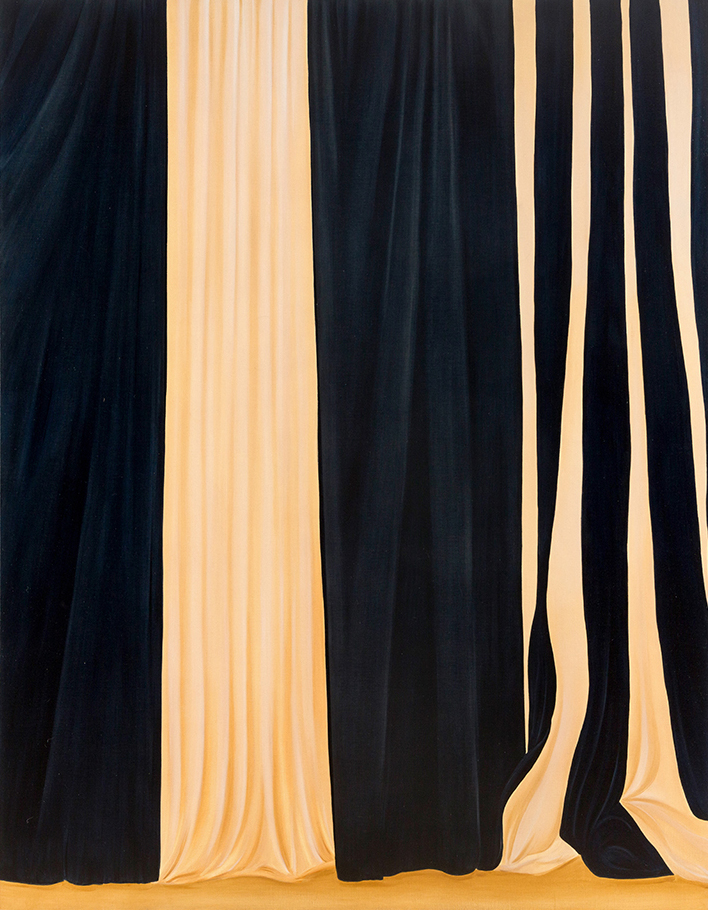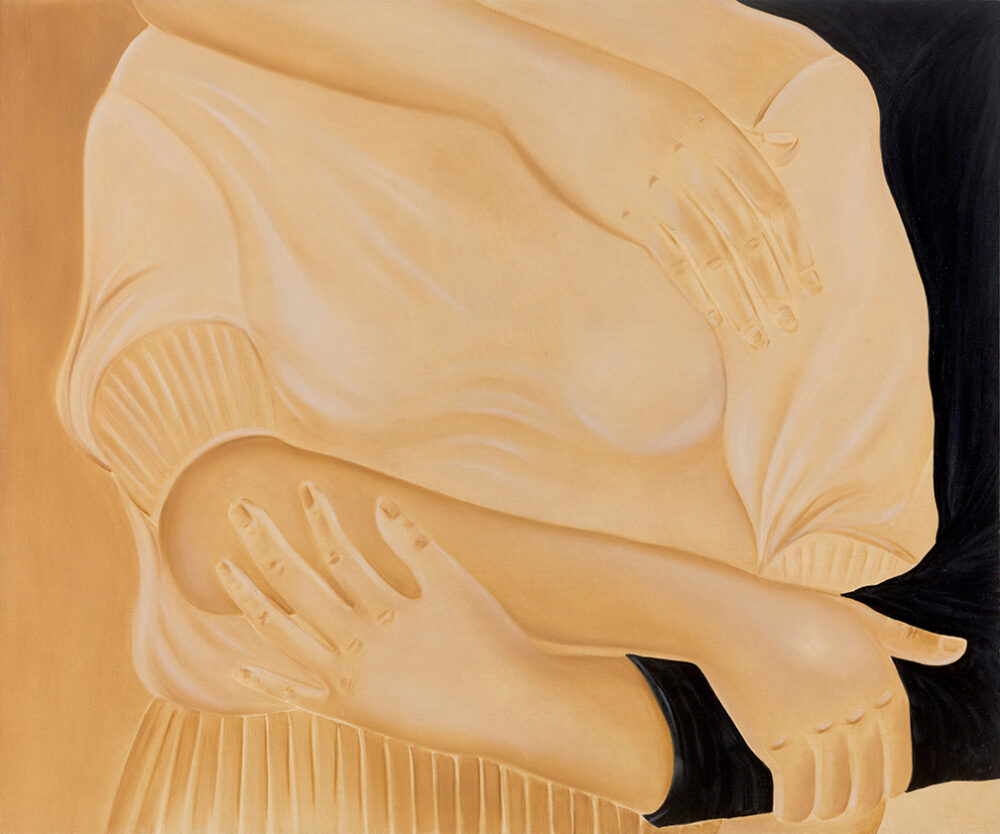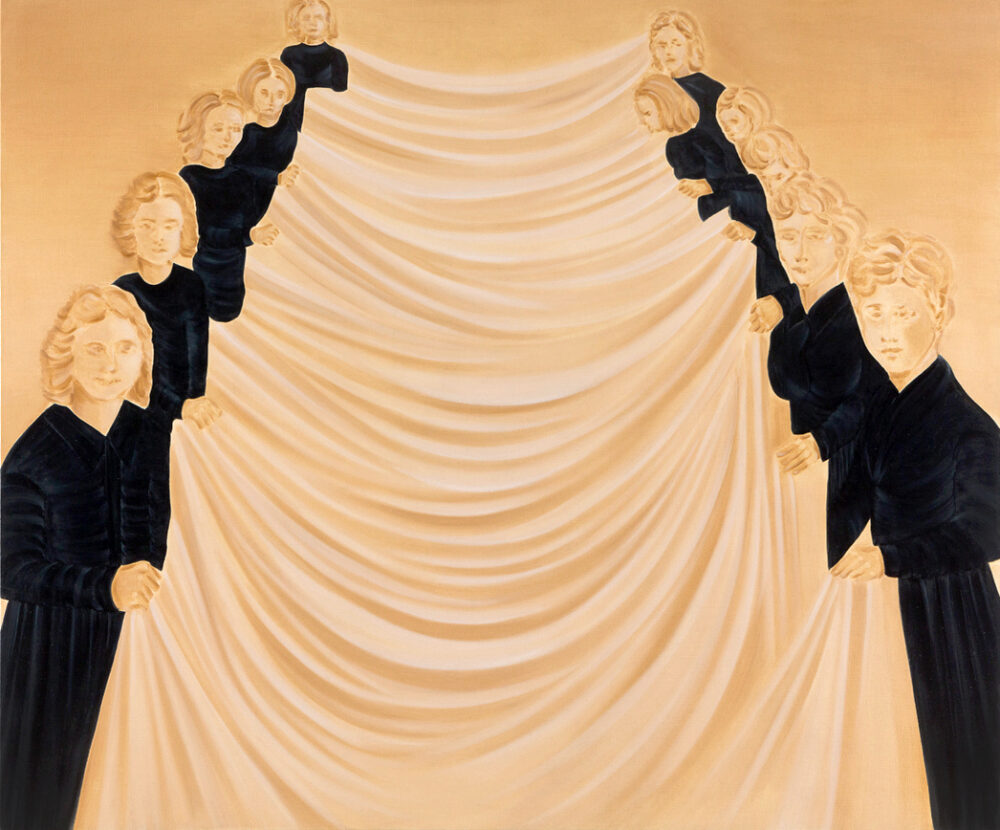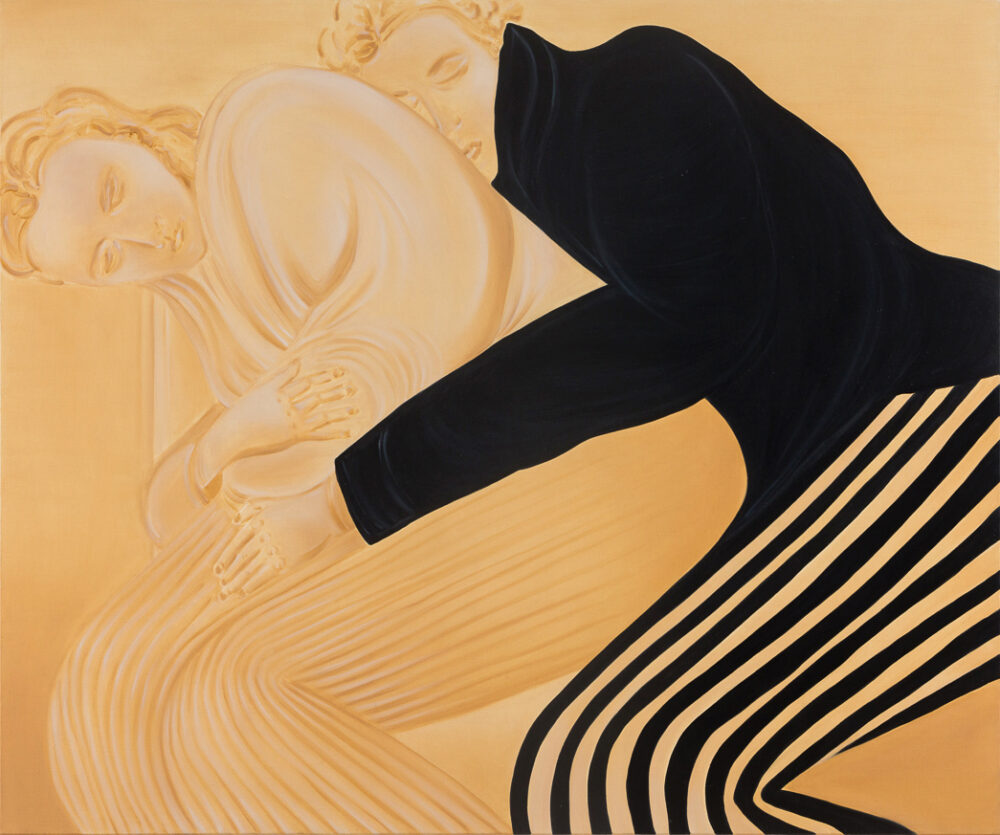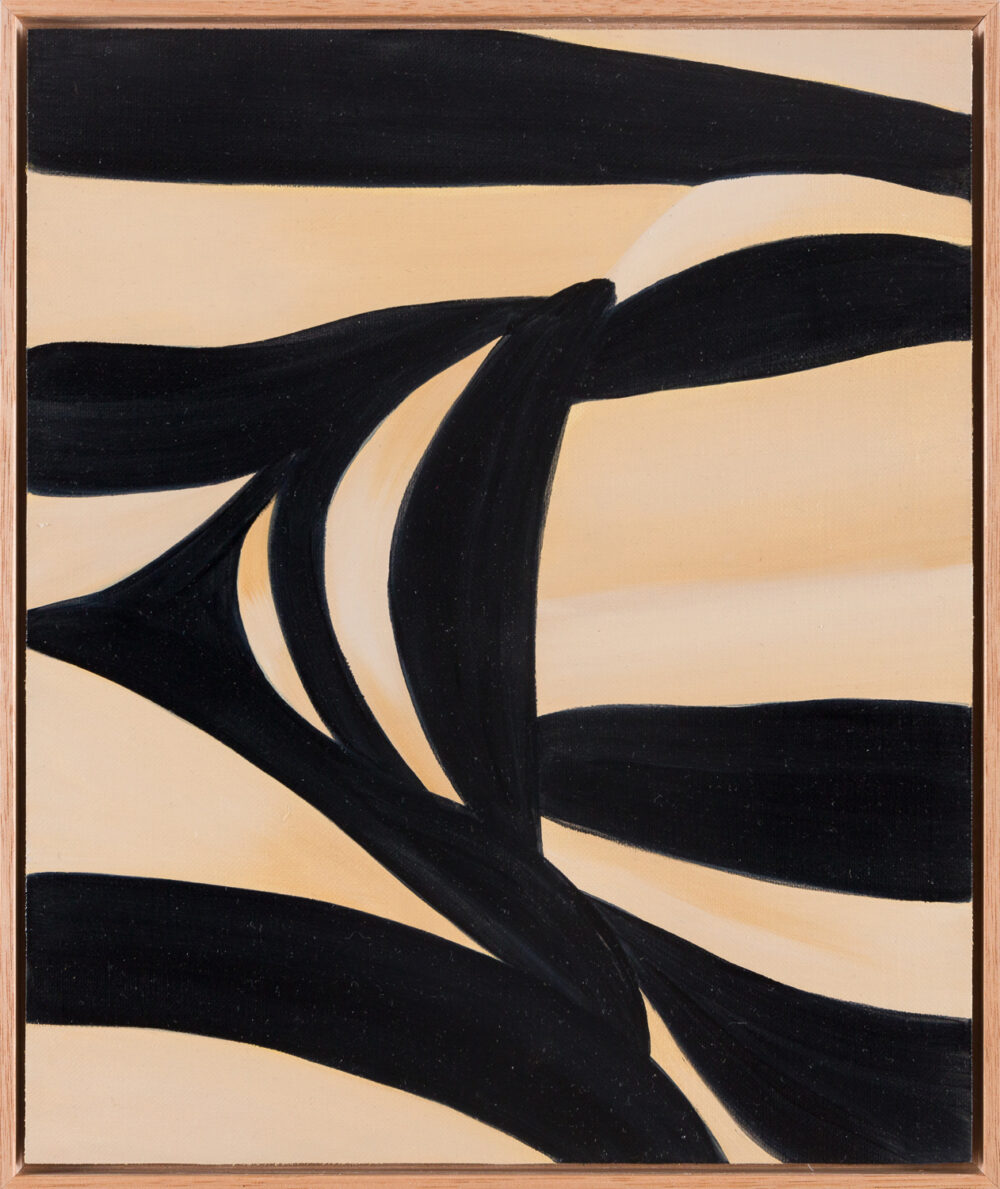Caroline Walls: Painting Now 2024
- Caroline Walls
- 24 Oct—23 Nov 2024
- Eora / Sydney
The opening of Painting Now sees the curtain rise on an exquisite new series by Caroline Walls, whose graceful paintings have amassed a passionate following among collectors, aesthetes and the design cognoscenti in Australia and beyond. Threaded with her reflections on the connections that form between women, her new works move gracefully between figurative and symbolic modes, their sumptuousness and subtle drama tempered by a restrained tonal palette that lends a mood of soft-edged elegance.
“I embrace limitation, working with a refined, reductive palette of only three paint colours: midnight blue-black, golden ochre and titanium white,” says Walls, whose work honours the richness and depth of women’s experiences, evoking the tenderness and strength that colours the bonds between women and gives their dynamic a transformative charge. “Through the considered mixing of these three hues, I craft a spectrum of subtle tones that aim to breathe life into my compositions, each one resonating with a quiet intensity.”
Drapery recurs through the artist’s Painting Now series, both with pictures in which figures gently embrace and in more ambiguous compositions where gathered pools of flowing fabric gesture to rich emotional worlds even in the body’s absence. “The fabric takes on a life of its own, embodying the presence, movement and emotion of the figure,” says Walls, who is a finalist in this year’s Rick Amor Drawing Award.
Dancing between the seen and unseen, the tangible and symbolic, these elements are described by the artist as both literal and metaphorical veils, “representing the layers of experience, secrecy and revelation that define women’s lives.” Works from Walls’s series are now on display at Michael Reid Sydney, where they can be previewed and acquired prior to this year’s Painting Now.
For more, please email dean@michaelreid.com.au

What were some of your early influences and how do they continue to inform your practice?
From an early age, I was drawn to visual storytelling through the human figure. This fascination was likely seeded by my aunt’s love of photography – she introduced me to some of her favourite photographers, such as Nan Goldin, Cindy Sherman and Tracey Moffat. Their way of exploring themes of vulnerability, identity and human relationships was fascinating to me. Goldin’s intensely personal documentation of her life and relationships, and Moffat’s blend of fiction with memory, has impacted how I think about narrative and the emotional resonance of my own work. I think seeing those worlds – whether real or imagined – encouraged a sense of curiosity about the inner psyche. Today I am still drawn to art that has a very human narrative. Those early influences have shaped the way I navigate themes of intimacy, womanhood and personal identity in my work.

What initially drew you to painting and how have you developed your practice over time?
Painting has always felt like the most natural medium for me to explore the subtle intersections of emotion, form and narrative. Having previously painted figurative pieces of womanly bodies, I spent some years exploring minimalism with highly reductive, abstract compositions but had a yearning to return to the more overtly figurative so have now come full circle. What drew me to oil painting was its potential for layering – both visually and symbolically. I love the way oil paint can be applied in translucent layers, revealing an underpainting and building a quiet depth over time. This sensitivity to layering is now at the core of my practice, allowing me to create dimensionality with minimal paint. I work with a restrained palette, often limiting myself to just three colours and mixing a multitude of tones to underscore simplicity and balance.
I’ve found myself returning to certain themes that feel essential to my work: womanhood, intimacy and connection. These manifest through the depiction of female figures and draping fabrics, which I use as symbolic stand-ins for the body. The relationship between the figure and the fabric speaks to the fluidity of identity, intimacy and the ways women relate to each other. My experiences as a woman and mother have deepened these explorations as I view my subjects through a very personal lens.
I’m continually drawn back to the idea of working with minimal materials – sparse layers of paint, careful attention to the tone of the underpainting, and a focus on the softness of form. There is something about the restraint in my process that mirrors the emotional complexity I aim to capture. This approach has allowed me to develop a style that I hope feels both delicate and intentional.

What have been some of your favourite career experiences?
Those that have allowed me to connect with others in meaningful ways. Each of my exhibitions has been a unique milestone. To have my work resonate with viewers, especially women who have shared personal stories after seeing the pieces, has inspired me and spurred me on. Being able to create a space for those dialogues around the varied experiences of womanhood and hearing how my work can make others feel seen or understood has been both fulfilling and reaffirming.
I love collaborating with other creatives – whether in group exhibitions or collaborative projects. Seeing how my paintings may fit into a larger conversation and learning from other artists’ approaches and stories has expanded the way I view my practice. I most love the moments spent in my studio, where the quiet focus of creating allows me to fully immerse myself. It’s in these moments that I often find the most joy.
Could you tell us about the works featured in Painting Now?
I’ve continued to explore how the female figure and fabric can express intimacy, identity and connection. My artworks capture my musings on my own life — the ordinariness and extraordinariness of the everyday experience. Fleeting moments that may seem mundane or insignificant but are imbued with intimacy and tenderness. I like to explore the complexities of human emotion and the universal longing for connection with others. I’m interested in the idea that human connections are non-linear – they flow freely, fluidly between people, transcending time and place, parallel to our own inner monologues.
One of the starting points for these pieces was the concept of touch – not just the physical act, but the emotional resonance it carries. As someone who has always been fascinated by the subtleties of relationships, I wanted to explore how touch can serve as both a bridge and a boundary between people. In these works, touch becomes a metaphor for human connection and the vulnerability it entails. I aimed to capture the fleeting nature of those moments – a hand brushing against skin or the tenderness of a body leaning into another. I hoped to reflect this in the softness of my painting technique by using delicate layers of paint and subtle shifts in tone.
The soft translucency of the fabric hints at the way emotions often lie just beneath the surface, waiting to be revealed. At times, the fabric becomes a veil, suggesting the ways we protect ourselves or keep parts of our inner lives hidden from others.
The experience of motherhood and my relationships as a woman have deeply influenced this exploration. How love can be nurturing, protective and tender, yet filled with raw complexity. Each piece in this collection is an attempt to explore those nuances, drawing the viewer into a quiet, intimate space where the figure and fabric become symbols of the unseen emotions that shape our relationships.

How do these ideas or narratives reflect the direction of your practice?
I found myself returning to the idea of connectedness. This narrative is very much reflective of where my painting practice is at right now. I’ve been increasingly interested in how to distil emotion and narrative into subtle gestures – whether through the choice of colour, the layering of translucent paint or the interplay between the figure and the fabric. My process has become more focused on simplicity and restraint, which I believe allows the emotional depth of the work to emerge more fully. I find that by limiting myself to a sparse colour palette and minimal use of paint, I’m able to concentrate on the nuances of form and feeling. This focus on the push and pull of human connection is something that runs through the entire collection.
As I continue to explore these themes, I’m interested in delving even deeper into the tension between connection and isolation or the concealing and revealing of ourselves to one another. The Painting Now series feels like a natural progression as I continue to refine my focus on the quiet complexities of human relationships, especially through the lens of my own experiences as a (queer) woman, mother, partner and artist.


